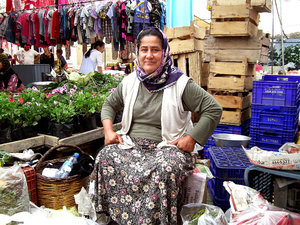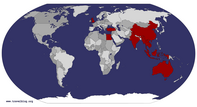Advertisement
Published: August 27th 2014

 Market Trader at Koycegiz
Market Trader at Koycegiz
The busy market at Koycegiz is a great place to buy fresh fruit, vegetables and other local produce. © V. Birch 2012The climb to the top of the hill had been tricky but the view from the top was spectacular. The path - little more than a goat track that wound its way up the rocky hillside - was precipitous in places and crossed back and forth over the remains of a fortified wall clinging to the hillside.
Lounging gratefully among the pungent foliage of
Artemisia and
Helichrysum on the summit (the latter plant smelling of curry), we took stock of our surroundings. A faint breeze blew across the summit plateau taking the edge off the hot spring sunshine that blazed down out of a clear blue sky. On one side of the hill, there were views out over the Dalyan Cayi - a reed filled marshland threaded with a maze of waterways - all the way to the Mediterranean that glittered on the horizon. In the other direction, we could trace the course of our route back along the road through the orange groves and across the river to the little town of Dalyan on the other side.
That morning, we had gotten up early, followed the riverside footpath from our guesthouse through town until we reached a little

 Lycian Tombs - Dalyan
Lycian Tombs - Dalyan
Dramatic rock cut tombs were a hallmark of the Lycian kingdom that stretched all the way along the Mediterranean Coast from Fethiye to Antalya. © L. Birch 2012jetty on the far side of a small park. There we hailed a boatman who, for a few
Lira, rowed us across to the other side of the river. We could see the hilltop that we would climb from town. It looked challenging. One side appeared to consist of a vertical cliff that dropped sheer to the river below. The other side was steeply sloped but looked more promising as a means to access the summit. Our first objective though, was to visit the ancient ruins of Kaunos, perched on the shoulder of the hill about 4 or 5km from town.
Although boat operators in town told us it was too far to walk and that we would be much better off taking one of their boats, the walk out to kaunos was easy - and extremely pleasant. Workers in the fields would stop to straighten their backs and raise a languid hand in greeting as we passed. It was also interesting to observe the small day-to-day rituals of farms where agricultural practices were still low key and in keeping with the environment. Bordering the road, there were hay meadows filled with flowers that obviously never saw artificial fertilizers

 Life Among the Ruins
Life Among the Ruins
An agama - one of several species of lizards to be found at Kaunos - catches some rays among the ruins. © L. Birch 2012or herbicides. There were birds too, like corn buntings and red-backed shrikes: birds that have long since disappeared from the English countryside.
The ruins of Kaunos were another pleasant discovery and one of the reasons we had chosen to visit this little corner of Turkey. When we were casting about for somewhere interesting to go, there were plenty of contenders for a quick getaway in easy travelling distance of the UK. France, Germany and Holland were just across the Channel of course, but their cultures were very similar to our own. No, what we wanted was something a little different. If possible, it also had to be somewhere that still provided a stamp in our passports. It was soon clear that we would have to go outside the European Union but not so far away that we would get jet-lagged getting there. Egypt, Tunisia and Morocco all fitted the bill but it was Turkey that finally caught our eye. It was a country we had never visited before. It had diverse landscapes, a rich history and cultural heritage and sat at the crossroads between Asia and Europe. The clincher came when we discovered that direct flights went there from

 All Life's a Stage
All Life's a Stage
The well preserved amphitheatre at Kaunos looks out over the Dalyan marshes and lagoon. © L. Birch 2012an airport just over 50 miles from where we lived.
And that was how we now came to be sitting on a hilltop in southern Turkey but before we had climbed up there, we had made our way up to a saddle further down where we could at last, look out over the remains of kaunos.
In the Shadow of Lycia Kaunos had been a Carian city, founded in the 9th Century (BC) that was built on the flanks of a fortified hill – hard up against the boundary with the neighbouring kingdom of Lycia. At that time, the Mediterranean once surrounded the hill where the city stood and a busy little harbour once served as a port-of-call for ships from as far afield as Troy and the ports of Greece. The influences of both the Hellenic region and that of Lycia were embraced by the Carians and can still be seen today in the form of an amphitheatre, Roman-style baths and the rock cut tombs so characteristic of the Lycian culture.
Today, the Mediterranean has retreated some 4km to the south. The silting up process that left the city surrounded by a malarial swamp must

 Iztusu Inlet
Iztusu Inlet
A boat enters the inlet to the Dalyan River on the Mediterranean Coast. © L. Birch 2012have happened gradually over many years but was no doubt partly responsible for the eventual demise of Kaunos. Wandering the remnants of its cobbled streets now, one can only wonder what it must have been like – the streets and squares thronged with market stalls and visiting traders from exotic ports. Of what remains, the acropolis and amphitheatre are perhaps the best preserved. It was tempting to walk onto the amphitheatre’s centre stage and raising a hand in entreaty, address an imagined crowd; “Friends, Romans, countryman – lend me your ears” (or any other body parts you can spare come to that).
Of course, there was no-one there but the ruins were far from devoid of life. Several species of lizard could be found, skittering away over rock walls at our approach and we were delighted by sightings of wild tortoise – nosing like tanks among the late spring flowers. Eventually climbing down from our rocky vantage point, we said a last farewell to Kaunos and retraced our steps back to the boat landing. There - after a drink at a little café surrounded by red geraniums - a sturdy woman in a patterned head scarf rowed us back

 Koycegiz Market
Koycegiz Market
There's no excuse for not eating your greens. Fresh fruit and veg on sale at Koycegiz. © L. Birch 2012to the other side.
In the days that followed, we made the almost obligatory boat trip to Iztuzu Beach – passing the fortified hill of kaunos as the boat wove its way through the Cayi to the sea. On the way, the boat stopped in a lagoon among the marshes where huge loggerhead turtles came inquisitively up to the boat. They swam around and beneath us - some were the size of a coffee table and looked as if they could easily overturn a canoe or small boat. The reason for their interest soon became clear when the boat captain produced a bucket of food scraps and began throwing them into the water. While I found this practice questionable, I could not deny that I was as excited as the other boat occupants to see these huge and extremely rare creatures at such close quarters.
Later, after we had been dropped off at one end of the 5km stretch of Iztuzu Beach, we walked to the far end of the bay and visited a turtle sanctuary to learn a little more about these gentle giants of the sea. Iztuzu was one of the last nesting beaches in the

 Pinching My Gozlume
Pinching My Gozlume
Gozlume were a marvellous discovery, a sort of pancake filled with a sweet or savoury filling of your choice. As a nod to my backpacker roots, mine was filled with Banana and honey. Trouble was, they were so good - you couldn't leave them unguarded for even a minute! © L. Birch 2012Med where loggerheads still came ashore to lay their eggs. The female turtles come ashore at night between May and September to lay their eggs in the sand - and therein lies the problem. The increasing popularity of Turkey’s south coast beaches with tourists was leaving the turtles with nowhere else to go. Fortunately, the sanctuary was part of a project set up to help save the turtles from disappearing altogether. As part of the scheme, staff helped rescue turtles injured by boats and marked nesting sites with stakes to protect them from being inadvertently trodden on. Education was a key part of the Trust’s work and volunteers worked tirelessly during the summer to help ensure that visitors were made aware of the dangers they posed to turtles - albeit unintentionally. Simple things like keeping out of certain sensitive areas, keeping off the beach at night and taking their litter away with them - were all things that visitors could do to help make a difference.
In the afternoon, a local bus took us back to Dalyan, passing through woods, fields and small villages where it seemed as if time had stood still for centuries. Getting back around 3.30pm,

 Dalyan Riverside
Dalyan Riverside
The view from our favourite spot on the riverside at Dalyan. It's a dirty job but someone's got to do it. © L. Birch 2012we ran the gauntlet of restaurant owners eager to get us into their establishments, shouted a quick
“Merhaba!” (Hello!) to those we knew and just had time to get down to the river in order to observe a little late afternoon ritual.
Evening Rituals At the end of each day, it had become our practice to be ensconced on one of the wooden jetties by the riverside before the 5 o’clock call to prayer began. A nearby mosque would be the first to start, the call then taken up by other mosques up and down the little river valley. As the sun dipped below the hills, the words of the Muezzin’s call;
“Al-Laah - Ou - Akbar”, (God is great) seemed to capture the essence of the moment as they bounced around and echoed from the sheer cliffs on the other side of the river.
It just seemed the right thing to do, sitting there with the evocative sounds of the evening call to prayer amplified by the parabolic sweep of the darkening cliffs. Swallows dipped low over the sparkling water and an early dragonfly darted by; all life was there, cupped in Allah’s hands. Looking down into the water, where fish played among the reeds below my dangling feet – it somehow seemed a fitting way to end another wonderful day in southern Turkey.
If you would like to find out more about the turtle conservation project at Dalyan, click on the link below
Dalyan Turtle Conservation
Advertisement
Tot: 0.283s; Tpl: 0.013s; cc: 23; qc: 129; dbt: 0.122s; 1; m:domysql w:travelblog (10.17.0.13); sld: 1;
; mem: 1.5mb











